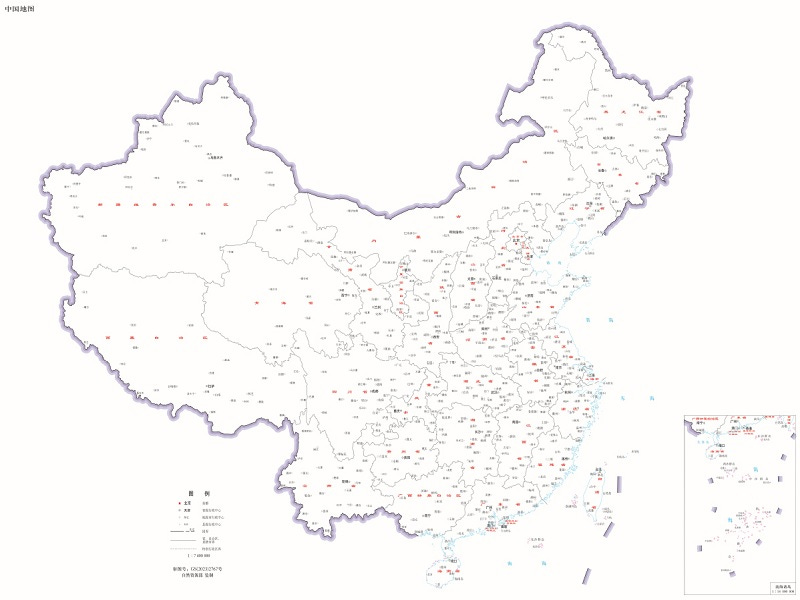China Made A Mistake On Its New Map That Sparked False Speculation About A Dispute With Russia
In the interests of the Russian-Chinese Strategic Partnership, it would be a good idea for Beijing to quietly modify the latest version of its annual standard map at its earliest convenience in order to remove the nearly indiscernible squiggle extending through the Russian half of Bolshoi Ussuriysky Island.
The release of China’s annual standard map last week was met with protests from India and the ASEAN states of Indonesia, Malaysia, the Philippines, and Vietnam, all of whom objected to it claiming disputed territory or opposed it staking claims outside the UNCLOS ambit like Jakarta did. Their territorial disputes in the Himalayas and the South China Sea are well known so this sequence of events was to be expected, but what caught observers off guard was the inclusion of an entire island partially under Russia’s control.
It's difficult to catch at first glance, but upon zooming in to the extreme northeastern part of Manchuria, one can see an almost indiscernible squiggle that aligns with the Russian half of Bolshoi Ussuriysky Island that was partitioned per a 2005 treaty that was then finally ratified by both parties in 2008. Barely anyone lives there, but it was the object of a long-running bilateral dispute that almost led to war in 1969 since it strategically sits at the confluence of the Amur and Ussuri Rivers near Russia’s Khabarovsk.
The latest annual Chinese standard map’s inclusion of the entire island as part of the People’s Republic was certainly a mistake since Russian Foreign Ministry spokeswoman Maria Zakharova clarified in response to Newsweek stirring up trouble about this that no bilateral territorial disputes exist anymore. She wisely chose to react diplomatically by reminding everyone of the international legal facts instead of calling attention to this mistake out of respect for China, with whom Russia is presently in an Entente.
Readers can learn more about the contemporary state of Sino-Russo relations from these analyses:
* 2 March: “Towards Tri-Multipolarity: The Golden Billion, The Sino-Russo Entente, & The Global South”
* 20 March: “President Xi’s Trip To Moscow Solidifies The Sino-Russo Entente”
* 7 April: “Korybko To Shyam Saran: The Sino-Russo Entente’s Dynamics Are Different Than You Think”
* 4 May: “RIC’s Differences Should Be Candidly Acknowledged Instead Of Denied Or Spun By Alt-Media”
* 5 August: “Why’d China So Strongly Object To Its Citizens Being Detained By Russia On The Kazakh Border?”
In sum, they’re unprecedentedly close, and they responsibly manage disagreements as they arise.
There’s no disagreement over Bolshoi Ussuriysky Island, however, and it doesn’t make sense to speculate that China intended to signal its interest in reviving this resolved issue through the publication of its latest annual map. After all, China and Russia are presently in an Entente whereby they coordinate their efforts to jointly accelerate the global systemic transition to multipolarity. This grand strategic goal is too important for China to derail by reviving its territorial claims to the entirety of that partitioned island.
It's unclear why this cartographical mistake wasn’t caught before publication since it presumably went through at least several layers of checks to ensure that it accurately reflected all the territory that China regards as its own, but it’s implausible to imagine that this was a deliberate provocation against Russia. Nobody is perfect, not even within whichever entity it was that the Communist Party of China tasked with carrying out this work, and sometimes the simplest explanation is the most likely.
In the interests of the Russian-Chinese Strategic Partnership, it would be a good idea for Beijing to quietly modify the latest version of its annual standard map at its earliest convenience in order to remove the nearly indiscernible squiggle extending through the Russian half of Bolshoi Ussuriysky Island. This mistake fueled Western efforts to sow suspicion between them and mislead others about their ties. It should therefore be fixed as soon as possible so as to nip this latest meddling operation in the bud.





Can you give us a reference, like this one: 48.189478321377315, 134.66985611569197, which we can copy and paste into Google Maps to come up with something like this: https://goo.gl/maps/DdbnCDigqr8b1yLt5, which doesn't have the names of little islands, like 'Bolshoy Ussuriysky' marked, please?
Despite going on and on about how clear their thinking is, the 'Newsweek' article you've linked to, although it in turn provides a link to yet more ever-so-clear&insightful (Exceptionally necessary) thinking about "China's New Map Claims Swathes of Neighboring Territory", I can't actually find anything to show me EXACTLY what we're talking about.
Please excuse me if I just haven't tried hard enough, but such 'journalism' as you've linked to seems to have some mystical means of gobbling up all my morning's patience. Please humour me, if you could be so kind.